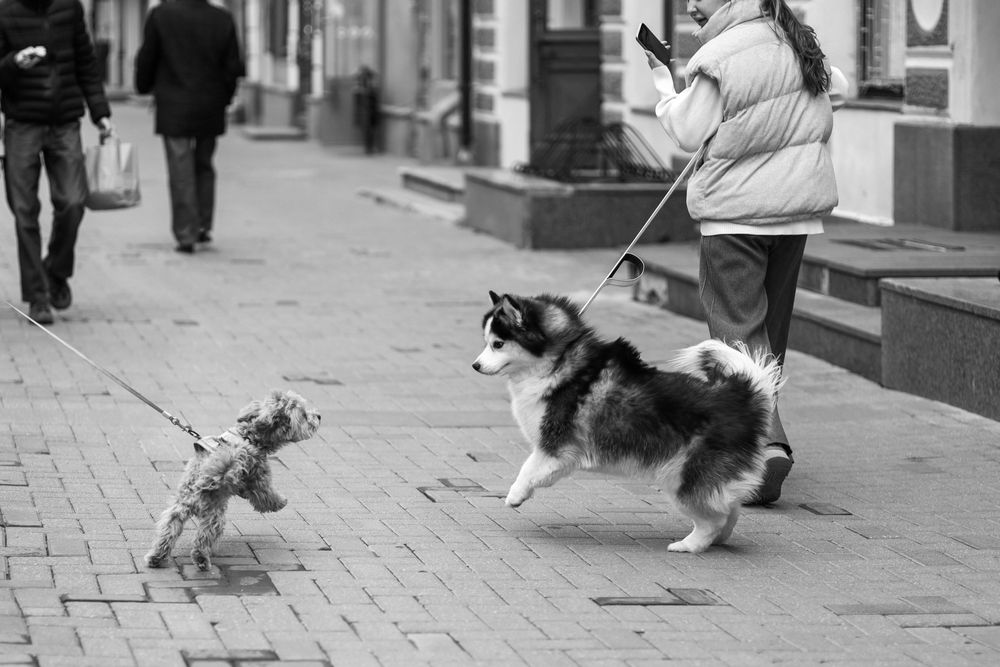
When to Skip the Leash Greeting: Why It’s Safer for Your Dog
Dog parents are often caught in a dilemma during walks: another dog approaches, the other owner smiles, and the question lingers — "Should the dogs say hello?"
On the surface, leash greetings — where two dogs meet and sniff each other while tethered to their respective humans — may seem friendly and natural. Dogs are social creatures, and many pet parents think allowing quick on-leash hellos helps with socialization. But while well-intentioned, leash greetings can actually create more problems than benefits.
Let’s explore why leash greetings aren’t always the safest option, and why being selective about how your dog meets others may be one of the best decisions you make for their well-being.
The Leash Changes Everything
Dogs naturally interact with one another through loose, flowing body movements. They rely heavily on spatial awareness, subtle shifts in weight, and the ability to freely circle or retreat when necessary. But the moment you clip on a leash, that natural freedom is gone.
On a leash, dogs can’t:
- Back away easily if they feel uncomfortable.
- Circle or arc around the other dog for a proper, polite greeting.
- Use space as communication, a key part of canine body language.
Instead, they are tethered to their human, creating tension — literally and emotionally. The leash restricts their natural movement, sometimes pulling them forward even if they’d prefer to create space. This forced proximity can change what would otherwise be harmless curiosity into stress or frustration.
As professional trainer Suzanne Clothier noted in her article He Just Wants to Say Hi!, dogs often rely on choice and distance to defuse tension. Removing those choices makes greetings feel unnatural, sometimes escalating into conflict.
The Myth of “Friendly Leash Greetings”
We’ve all heard someone say, “Don’t worry, my dog is friendly!” But even “friendly” dogs can react poorly when on leash. The restraint amplifies emotions: a confident dog may become too pushy with no room to adjust, while a shy dog loses the option to retreat.
Some risks of on-leash greetings include:
- Barrier frustration: Dogs may become frustrated when they can’t approach properly or move as freely as they want, leading to lunging, barking, or snapping.
- False first impressions: Dogs meeting stiffly face-to-face — something they rarely do off-leash — can be seen as threatening in canine body language.
- Human influence: Without realizing it, owners often tighten the leash at the crucial moment, communicating tension right down the line.
What might look like two wagging tails can in seconds shift into growls, nips, or a scuffle. And even if the encounter never escalates, your dog may begin associating seeing other dogs on walks with stress.
Why Avoiding Leash Greetings Protects Your Dog
Avoiding leash greetings isn’t about being antisocial — it’s about protecting your dog’s mental and physical safety. Here’s why many trainers recommend skipping them:
Safety First
A tense, awkward greeting puts both dogs (and people) at risk. Even a minor scuffle can lead to injuries, expensive vet visits, or dogs becoming fearful of encounters in the future.
Better Socialization Happens Elsewhere
True dog socialization takes place in controlled, safe environments — off-leash play yards, structured group classes, or with dogs you and your pup know well. On the sidewalk or trail, the conditions are usually unpredictable.
Focus on the Walk
Walks are primarily for mental enrichment, exercise, and bonding with you. By skipping greetings, your dog learns to ignore distractions and pay more attention to you, strengthening your teamwork.
Respecting Your Dog’s Comfort Zone
Not all dogs want to greet others. Some prefer their walks without interruption, and forcing interactions can unintentionally create anxiety or reactivity.
Alternatives to On-Leash Hellos
The good news is, avoiding leash greetings doesn’t mean your pup has to miss out on socialization. Instead, you can set up safe, positive experiences with other dogs:
- Organized playdates: Arrange off-leash time with dogs you know have compatible play styles.
- Training classes: Group classes expose your dog to other dogs in a controlled space without pressure to physically interact.
- Parallel walks: Walking a safe distance alongside another dog allows both to exist together calmly without the stress of face-to-face confrontation.
These alternatives provide the benefits of socialization without the risks that come with tense, tethered greetings.
Handling Encounters with Other Dog Parents
Of course, real life brings unexpected encounters. If another owner tries to approach for a leash greeting, it helps to have a polite, prepared response. You might say:
- “Thanks, but we’re working on leash manners today.”
- “My dog doesn’t greet on leash, but thanks for asking.”
- “We’re training right now — maybe another time.”
These responses are respectful yet firm, making it clear that your dog’s comfort and safety come first. If necessary, simply step aside and keep moving.
Listening to Your Dog
Every dog communicates through subtle body language — the way they stiffen, glance away, or lean into or out of the leash. Learning to read these signals can help you advocate for them. If your pup seems tense, lowers their ears, yawns, or pulls away, they’re giving you feedback: “I don’t want this greeting.” Respecting that boundary can make a huge difference in your dog’s trust and confidence.
Final Thoughts
Leash greetings may seem harmless, but beneath the good intentions lie hidden risks. Restrained by a leash, dogs lose the ability to communicate naturally, potentially turning curious encounters into stressful or dangerous ones. By avoiding promiscuous “walk-up” greetings and instead focusing on safe, structured socialization, you protect your dog’s comfort, safety, and trust in you.
At the end of the day, your dog doesn’t need to meet every canine they pass on the street. What they need most is your advocacy — knowing you’ll protect them from uncomfortable situations and let them enjoy their walk for what it truly is: quality time by your side.